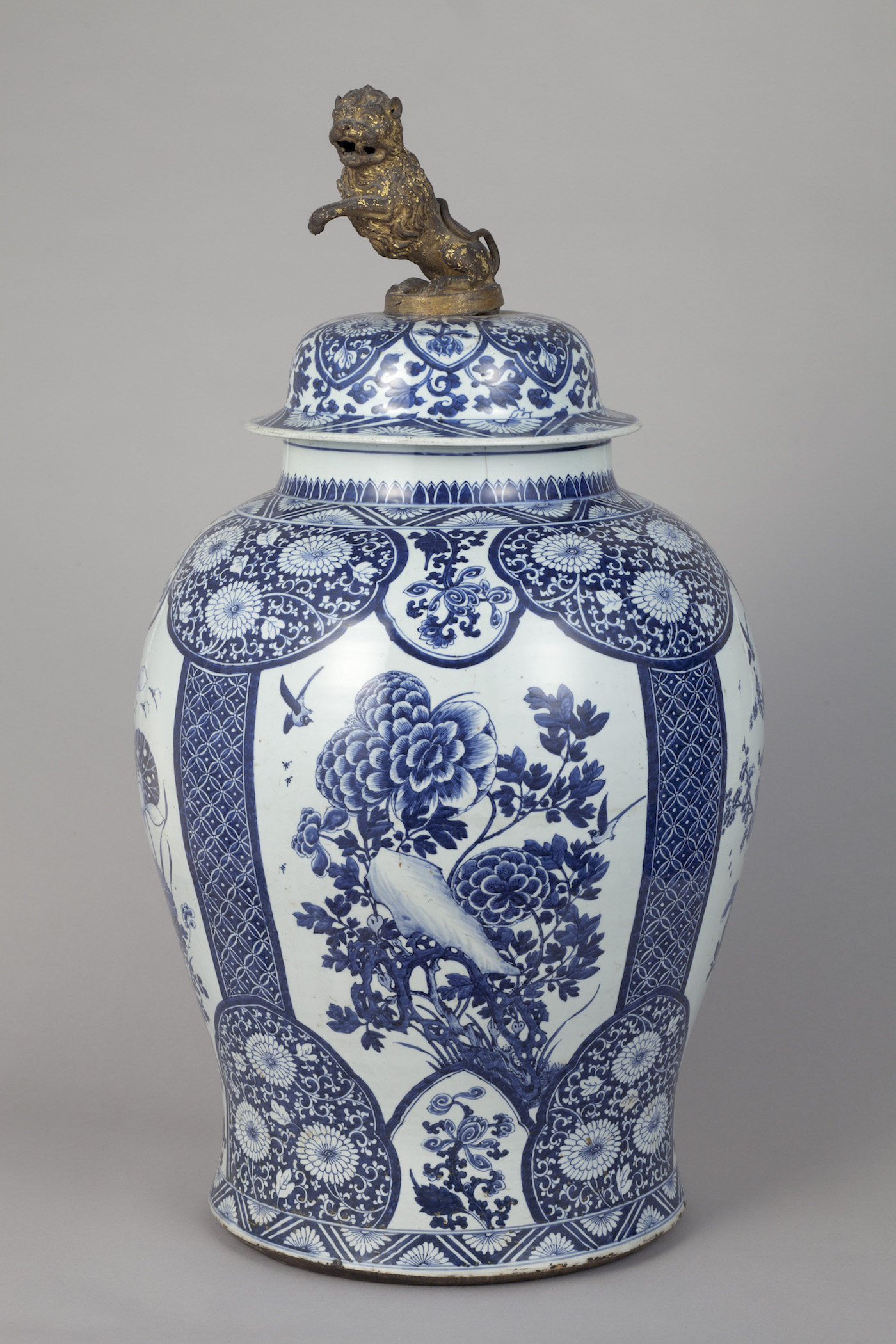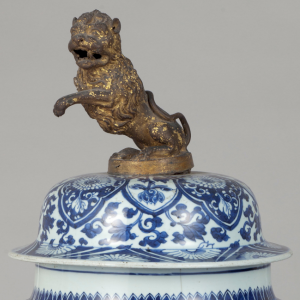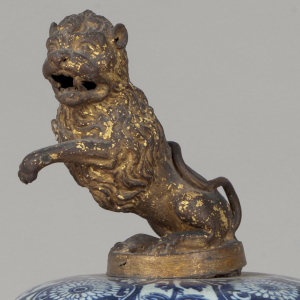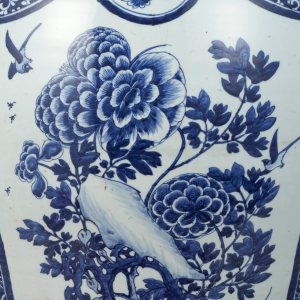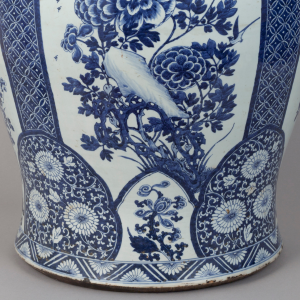Pot
Author: Unknown
Origin: Jingdezhen Kilns, China
Dating: 17th century (Qing Dynasty, Kangxi period)
Material: Porcelain
Dimensions (cm): 90 x Ø 50,5
Inv. no.: PD0480
One of two pots, in thick white porcelain, painted in cobalt blue on a white glaze. The lids – of Western origin – are topped by rampant lions in gilded metal.
These pieces are filled with symbolism and express good luck, not only through the decoration with flowering branches – representing the four seasons – but also through the representation of various insects – symbolizing longevity and the renewal of the cycle of life.
Porcelain objects were not only treasured in China, but also in the rest of the world. The elegance and quality of Chinese porcelain earned the attention of the Portuguese. At the beginning of the 16th century, it began to be massively imported into Europe and became greatly appreciated among the wealthy classes.
Porcelain emerged, in China, between the 6th and 7th centuries, as an improvement of stoneware – obtained due to the use of a plastic clay (kaolin) fired at high temperatures (+1200 ºC or +2192 ºF).
It began to be produced in the Tang dynasty (618-906), having developed intensely in the Ming dynasty (1368-1644) with the discovery of kaolin. It reached perfection in the mid-14th century.
“Flora in the Palace’s Collections”
«The term chrysanthemum – from the Greek chryos (gold) and anthemom (flower) – was first recorded by Carl Linnaeus, in May 1753, in his work […] Species Plantarum, although he hadn’t a correct idea of the flowers to which he referred. However, the flower had already been mentioned by a botanist from Danzig, Jacob Breyn, in 1689, in his Prodromus Plantarum Rariuorum, where he reports that chrysanthemums were grown in Dutch gardens and in the Chelsea apothecaries’ garden in England, although, currently, there is no trace of this plantation.
[…]
However, the flowers already had a very ancient cultural history in China, since their first allusion to autumn and to the passage of the migratory route of geese in the Classic Rites, dated between the 5th and 3rd centuries BC. Also called gold flowers in China, these chrysanthemums would have a wild character with small flowers, mostly yellow in colour.
Sure, here is the translation of the text into English:
The term chrysanthemum, from the Greek chryos (gold) and anthemom (flower), was first recorded by Carl Linnaeus in May 1753 in his work of modern nomenclature Species Plantarum, although without a correct idea of the flowers to which he referred. However, the flower had already been mentioned by a botanist from Danzig, Jacob Breyn, in 1689, in his Prodromus Plantarum Rariuorum, where he reports that chrysanthemums were grown in Dutch gardens and in the Chelsea apothecaries’ garden in England, although currently there is no trace of this plantation.
However, the flowers already had a very ancient cultural history in China, since their first allusion to autumn and the passage of the migratory route of geese in the Classic Rites text, dated between the 5th and 3rd centuries BC. Also called gold flowers, in China, these chrysanthemums would have a wild character with small flowers, mostly yellow in color.
Their growing cultural influence in China – and subsequent development of dozens of varieties in Japanese lands – is mainly due to one of the great experts in floriculture and a poet passionate about the species, Táo-Yuan-Ming (365-427) – to whom varieties grown in gardens are attributed and recognized, nowadays, as the specimens of the standard flower typology. Through the example of this poet – living as a hermit in an area far from the human bustle, renouncing the sorrows of the world and in absolute unison with nature to dedicate himself to the cultivation of chrysanthemums – it is still a common practice for those who reach the autumn of life in China to cultivate chrysanthemums. Concomitantly, the theme of cultivating these flowers in retirement has remained continuously popular in Chinese poetry – expressing the ideal of a period in which human achievement can be fully expressed.
Symbols of intellectual merit and joy for the positive achievements of life, chrysanthemums represent autumn and are particularly celebrated at the festival of the ninth lunar month. In the Chinese, its name jú is associated with other homophonous morphemes – with great auspicious value – such as jiu (longevity) and ju (perseverance). Also for this very reason, the ingestion of the tisane made from the flowers has the merit of being one of the oldest products related to the Taoist concept of the search for immortality – illuminating the body until reaching the ethereal state of immortals, capable of fly and, with them, ride the clouds.
[…]
[This pot] features a luminous decoration of chrysanthemums […], both on the base and on the shoulders. Curiously, as in other cases, the visual culture of flowers in export porcelain preceded the fashion of growing them in European gardens.»
Sasha Assis Lima
